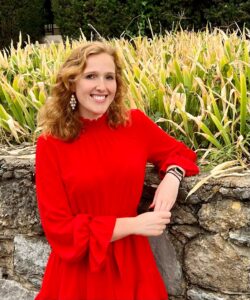 Chloe Frame, 5th year Chemical Engineering PhD Candidate in the McCabe Lab
Chloe Frame, 5th year Chemical Engineering PhD Candidate in the McCabe Lab
Summary of Research:
My work focuses on the outermost layer of the epidermis, the stratum corneum, which consists of corneocytes (dead skin cells) embedded in highly organized lipid lamellae. This lipid matrix is responsible for the barrier function of skin and one of the ways to study the skin barrier is by understanding the effect of the lipid composition. Through the study of lipid composition, we can gain insights into 1) how to enhance the skin barrier’s protection, particularly in cases of skin diseases such as eczema or psoriasis and 2) how to manipulate this barrier effectively to facilitate the targeted delivery of specific molecules in drug delivery applications.
The composition of the stratum corneum lipid matrix is complex in lipid chemistry and lipid size but is simplified into a classification of three types of lipids: ceramides, cholesterol, and free fatty acids. Experimental model lipid membrane systems have been used to study the effect of composition on lipid specific interactions, but little is known about the molecular-level interactions happening within and between these lipids.
To probe lipid molecular level arrangement, we performed molecular dynamics simulations with both atomistic and coarse-grained models of several types of ceramides, cholesterol, a range of saturated fatty acids, and water. Atomistic models provide highly detailed structures with atomic scale precision but are computationally expensive when examining complex biological phenomena. We therefore developed a computationally efficient coarse-grained model that groups atoms and their interactions to be simulated quickly, while still retaining enough chemical detail to accurately capture the key structural aspects of the lipid lamellae. This multiscale approach allows us to simulate time scales ranging from a few femtoseconds to capture the quickest bond vibration within a hydroxyl group between an oxygen and a hydrogen up to the microsecond timescale required to examine the random organization of lipids via self-assembly.
We combine our multiscale simulations with experimental model lipid systems like those from our collaborators at Leiden University, where together, we provide a comprehensive understanding of how lipid composition influences the formation of the lipid matrix, shedding light on the barrier properties of both healthy and diseased skin.
My Journey:
My graduate research career has been anything but straightforward. I came to Vanderbilt in fall 2019 full of enthusiasm. However, like countless others, the pandemic’s arrival during my second semester significantly disrupted both my research and the learning experience. Navigating a new scientific field and learning new skills remotely was an intense challenge. Consequently, I sought out every opportunity and resource available at Vanderbilt. VINSE was one of those resources.
The most rewarding aspect of VINSE is the strong sense of community it fosters. It goes beyond the state-of-the-art resources, emphasizing the camaraderie and support among like-minded individuals who are collectively dedicated to tackling complex nanoscale challenges. We come together regularly, formally and informally, drawing from our diverse backgrounds and distinct research interests to celebrate each other’s contributions to the world of nanoscience. The outreach opportunities are amazing as it provides opportunities to mentor and teach young scientists about this expanding field.
This community helped serve as an anchor, helping to keep me grounded and providing support. At the end of my third year, my advisor announced her departure from Vanderbilt. Research was promised to continue remotely, but there was still fear of uncertainty. But instead of it becoming a roadblock, I adapted quickly because all this time, I had been learning how to become an independent researcher.
One of the ways I ensured success was embracing collaboration. Our experimental collaborators at Leiden University in the Netherlands became my greatest resource. It was amazing to see how my simulations were able to validate and further explain findings they were observing in their lab benchtop experiments. Through this collaboration, I not only gained valuable insights into advancing skin lipid model systems, but also expanded upon skills acquired during my time at Vanderbilt, discovering their applicability in a world beyond academia. Additionally, I’ve always been supported and encouraged by my advisor to share my work, wherever that may take me. I have had the privilege of presenting my work at conferences and meetings not only in the United States, but in the Netherlands, Spain, and Scotland. At the recent European Epidermal Barrier Research Network (E2BRN) annual meeting in Edinburgh, my talk was awarded as one of the best Oral Presentations at the conference.
My journey, much like that of many young researchers, was filled with many challenges. I am grateful to VINSE, especially to Sarah Ross, for encouraging me and imparting the lesson that, although we often tackle nanoscale problems, sometimes the solution lies in thinking bigger and looking further away.
Contact: Chloe Frame